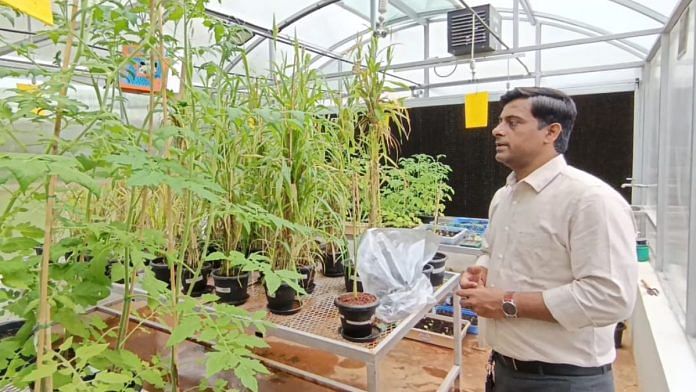Bengaluru: Scientist PV Shivaprasad wants to toughen up our crops. They’re falling prey to unseasonal rains. High salinity in the soil is killing them. They’re burning in harsh summers, and are more vulnerable than ever to pests.
“We have pampered our plants so much that they have lost their ability to fight against what’s trying to kill them,” said Shivaprasad, associate dean of research at Bengaluru’s National Centre for Biological Sciences (NCBS). It goes back to the Green Revolution.
“During the Green Revolution, we shut down all their resistance mechanisms. And made them produce more grain. It was a necessity in times of famine, but it has left plants weak, especially in changing climatic conditions. They can’t cope,” Shivaprasad added.
Now, he is “de-domesticating” the rice crop by tweaking its genes to make it salt resistant. And he’s not the only scientist re-arming plants. At the Tata Institute for Genetics and Society (TIGS), also in Bengaluru, a team is gene editing rice to make it more tolerant to herbicides needed to stem the rising tide of weeds. Another team is trying to regulate photosynthesis at the molecular level.
From gene editing to training drones to monitor the health of plants and soil, scientists, researchers and entrepreneurs are using every tool at their disposal to breed new varieties of crops that can not just survive but thrive under the assault of a changing climate.
“In the last five to 10 years, we’ve started thinking that yield is secondary. But first, we have to ensure crops can cope with climate change,” said Shivaprasad, who is from a family of farmers in Udupi, Karnataka.
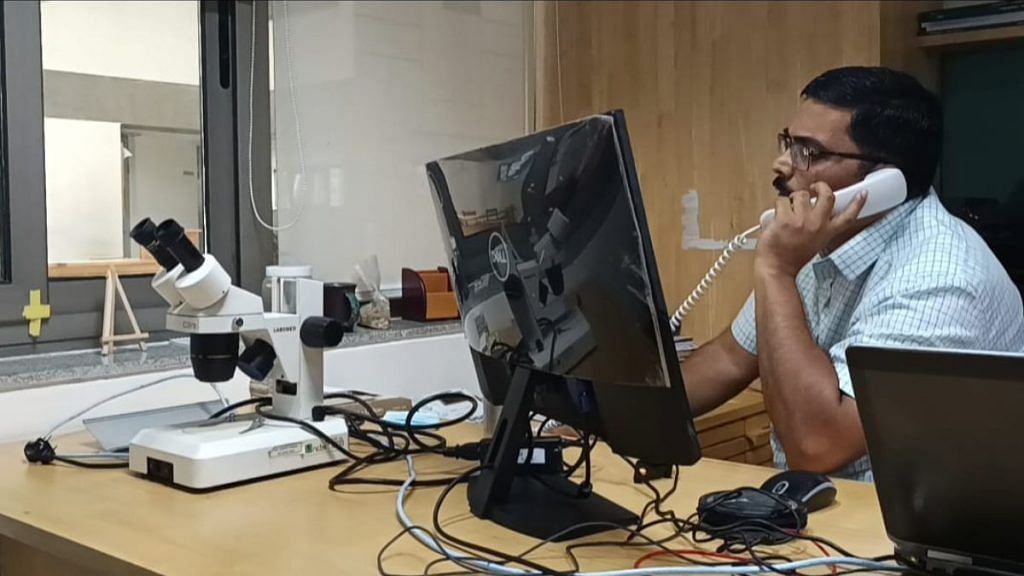
There’s an urgency driving scientists across India, given that agriculture as an economy is highly sensitive to the impact of climate change. In May this year, India unveiled the world’s first gene-edited rice varieties, DRR Dhan 100 and Pusa DST Rice 1. In trials, both crops showed 19 per cent higher yields, and a 20 per cent reduction in greenhouse gas emissions, and had improved tolerance to drought, salinity, and climate stresses.
In the United States, scientists have developed cherries that need one-third the usual amount of cold weather and cauliflowers with sunscreen. And in the UK, researchers have edited rice plant leaves to prepare them to flourish in highly saline conditions by changing the stomatal density.
“India is expected to be among the countries most severely impacted by climate change, and agriculture is particularly vulnerable. So, developing climate-resilient crops is a top priority for ensuring food security in India,” says Kutubuddin Molla, senior scientist (biotechnology) at ICAR-Central Rice Research Institute, Cuttack.
Also read: 6 years, 400 trials, and a breakthrough—how Kashmir gave India its first gene-edited sheep
Prepping plants for defence
As many as 20 bottles of rice varieties from across India sit on Shivaprasad’s desk at his office in NCBS. His team has found a way to tweak the rice crop to fight against increased salinity in the soil where the water easily dries off. The excess presence of salt makes the plants weaker.
These are not genetically modified organisms or GMOs where DNA is altered by introducing foreign genetic material. Instead, in gene-editing, as the name suggests, the plant’s existing genes are altered.
Shivaprasad and his team focussed on histones. Think of them as spools that DNA wraps around to maintain its form. The NCBS researchers used histones to turn genes on and off. The team played around with different variants of histone to understand how they express particular traits when under stress. While studying the Histone4 variant, they discovered a special protein H4.V that helps rice plants survive in salty conditions. The protein works like a switch, turning off certain genes under normal conditions and switching them back on in saline conditions.
Without H4.V, the plants struggle to grow and handle salt stress, showing how important this protein is for their survival.
When researchers analysed the edited plants, they found the gene activity matched that of plants under salt stress, though no external stress had been applied. Further, when exposed to an actual saline environment, the mutants showed no additional response as they were already in a stress condition.
Just a few metres away from Shivaprasad’s cabin is his greenhouse, where gene-edited rice crops are kept under observation. Salinity is just one among the many villains the plants fight.
The plants were now like commandos who trained intensely on an obstacle course. The results show that H4.V contributed to the ability of rice to cope with salt stress conditions. Their findings were published in Nature Plants last April.
While Shivaprasad and his team are preparing paddy to thrive in salinity, next door, principal scientist Sresty Tavva from the Tata Institute for Genetics and Society (TIGS) is gene editing crop plants to improve various traits of interest; one of the aspects is to develop herbicide tolerant rice for improved performance under aerobic and irrigated conditions.
“When you spray the chemical, you are killing weeds, but at the same time, you are also affecting your crop plant,” said Sresty.
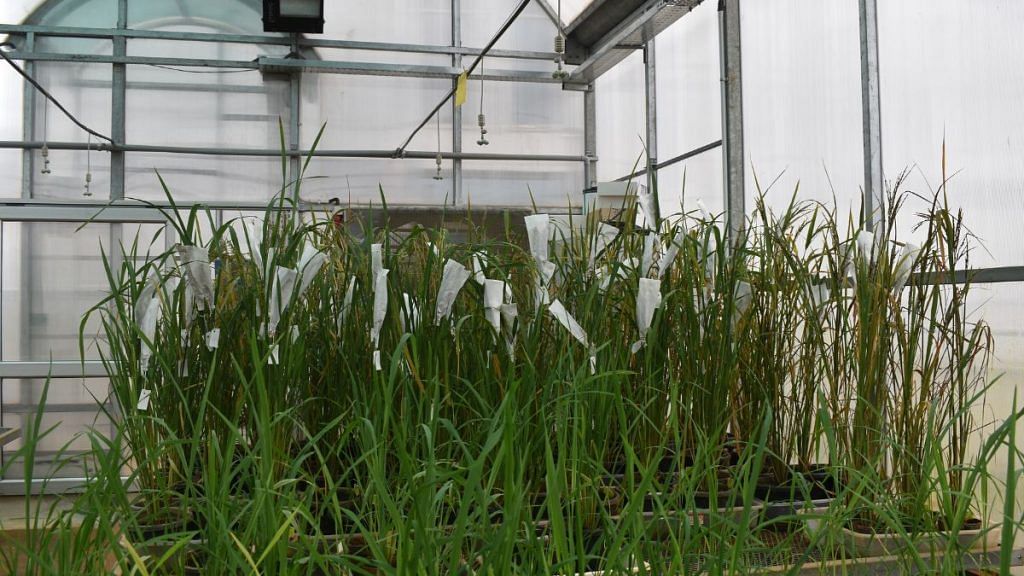
Editing a gene
At first glance, the top floor of the Tata Institute for Genetics and Society looks like a commercial plant nursery. Within two hemispherical domed houses, rice plants in different shapes and varieties are arranged on racks.
Every few minutes, two large exhaust fans buzz to suck the humid air out of the room to make it cooler and regulate the temperature. At the same time, water droplets drip through a honeycomb maze at the other end of the greenhouse, replenishing humidity levels. This allows the plants to be grown in a controlled environment with the right humidity required for the experiment.
It’s where Sresty grows rice to test the efficacy of gene-edited rice crops. The team is working on ways to make the deep-rooted rice variety—which was developed by his colleagues at the University of Agricultural Sciences, GKVK Bangalore—suitable for aerobic cultivation and tolerant to herbicide chemicals.
Editing a plant’s gene starts with the introduction of foreign DNA. Transgenes act like molecular scissors and make the desired cut as targeted in the plant’s DNA. After the edit, the plant is grown over generations. For rice, it takes two to three generations to check the stability of the edit and ensure that the final edited plant is free of any introduced foreign DNA.
“The introduced foreign DNA should not be present in the final edited plant. If it is there, then it is considered a transgenic plant. That comes under different approval rules,” explained Sresty.
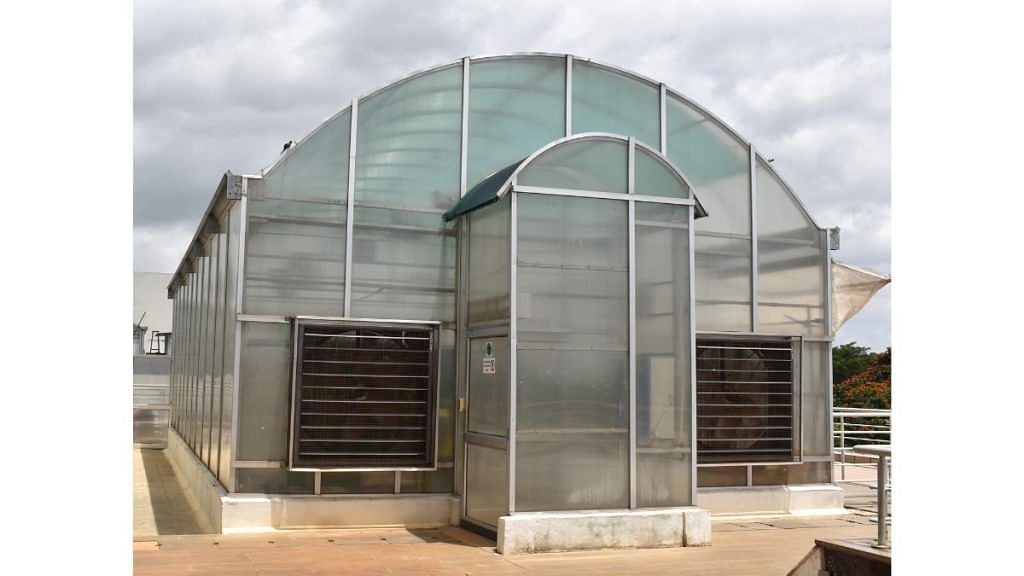
The edited crops are yet to make their way to the greenhouse for further testing. The team is in the process of collecting data from the genome-edited rice plants to obtain approvals for field trials.
On the same campus, at the Centre for Cellular and Molecular Platforms (C-CAMP), entrepreneur Vivekanand Tiwari is working on helping plant proteins store more energy to grow in adverse weather conditions like drought at his life sciences startup VitaCrop Technologies.
During his post-doctoral stint at Weisman Institute of Science in Israel, Tiwari’s research group wanted to understand how photosynthesis can be regulated at the molecular level inside the plants and how they can take advantage of this. The team found a particular protein, which, when tweaked, showed higher energy-storing capacity. Using that, they successfully developed a technology to improve the photosynthetic efficiency of the rice plant so that it can perform better in limited and harsh conditions like drought.
At his greenhouse, much smaller than the one at TIGS, Tiwari screens generations of gene-edited plants to filter out varieties that contain the foreign DNA so that the offspring are not genetically modified.
These experiments from Shivaprasad, Tiwari and Sresty are all grown to fight the rampant change in climate that impacts agriculture.
“These crops can help farmers adapt to changing environmental conditions and sustain agricultural productivity in the face of climate-related challenges,” said Molla.
Also read: How Punjab farmers sacrificed high income for a big cause—they gave up Pusa-44 this year
Aerial watchdogs
Gene editing is just one part of the fight to make crops more resilient. Increasingly, drones, artificial intelligence and geospatial technology are being roped in as well.
Farmers usually look to satellite data for vegetation and plant health information and to understand when to harvest. But Devan Chandrasekharan, an aeronautical engineer by training, understood that relying solely on satellite data doesn’t guarantee accuracy, especially when a large patch of cropland is obscured by clouds.
Chandrashekaran, who worked on underwater drones while in Mount Zion College of Engineering, Pathanamthitta, Kerala, expanded on his idea once he launched his own startup, Fuselage Innovations, in 2020.
He developed aerial drones that scan a patch of land, analyse the deficiency and characteristics of the crop, and inform the farmer about where to spray the fertilisers. This solves the problem of massive use of fertilisers and promotes sustainable farming.
The idea occurred to him as he read a UN report stating the loss of nutritionally rich topsoil due to rampant floods that had hit Kerala in 2018.
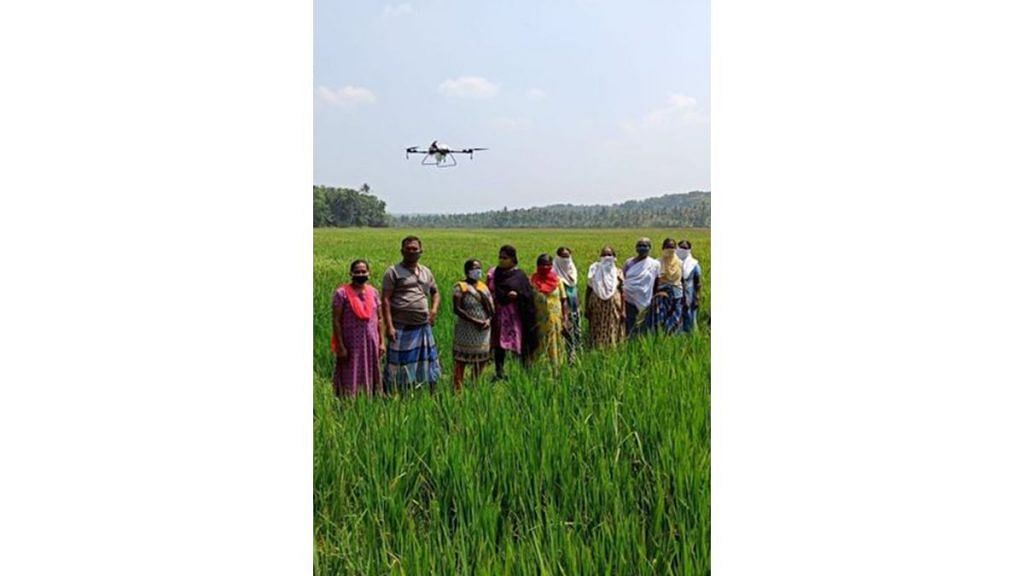
“It was during mid-Covid-19 in 2020, and investors, as well as the bank officials, found it difficult to understand the feasibility of my startup,” said Chandrasekharan, who walked in and out of around a dozen banks across two districts in Kerala to secure funds to develop a prototype of his drone. Later, he started the project with a grant of Rs 3 lakh from Tata Consultancy Services and incubated Fuselage Innovations in Maker Village, Kerala Technology Innovation Zone, Ernakulam.
Fuselage was also supported by UNDP India in 2021 through the Green Innovation Fund. So far, he has sold 200 drones to farmers across Kerala.
Another lesser-known aspect of drones is how they help farmers identify the evolution of bugs due to extreme weather conditions. Typically, what farmers do is counter bugs before they evolve and mature in a fixed period. However, due to changes in atmospheric conditions such as temperature, new bugs of a different maturity period might grow on the crops, making it harder for the farmers to kill the bugs. Multiple drones can scan a patch of land to identify how the bug grows and then spray chemicals to kill them before they mature. Fuselage’s drones have the ability to do this.
All these technologies have the potential to help farmers whose fortunes are linked to weather patterns.
Last September, the Union Cabinet approved Mission Mausam to make India “weather ready” and “climate smart” by enhancing the “country’s weather and climate observations, modelling and forecasting, leading to better, more useful, accurate and timely services.” The project is supported with a Rs 2,000 crore budget for two years.
Assisted technologies like gene editing, drones that survey the land, and accessibility of weather data could equip farmers to fight extreme changes like erratic rainfall and drought.
For Tiwari and Shivaprasad, it’s not just professional, it’s personal as well.
“I come from a farmer’s family. My parents, who are still doing agriculture, put a lot of effort and money into it. A majority of farmers don’t care about the science because their survival is more important. If some varieties can give ten or twenty per cent better yield, they will accept that [technology],” said Tiwari.
(Edited by Theres Sudeep)



